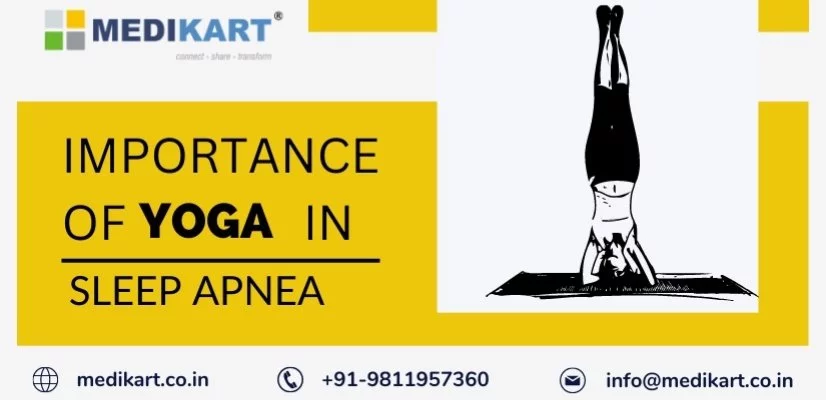Importance of Yoga in Sleep Apnea
Obstructive sleep apnea occurs when the muscles in your upper airway collapse and restrict your airway, forcing you to wake up to breathe. It can happen anywhere from a few to hundreds of times per night (depending on the severity of your disease), and it usually happens without you realizing it. It has a significant impact on your sleep.
Yoga and Sleep Apnea
Many adults, particularly those in their older years, suffer from sleep difficulties like Insomnia and sleep apnea. According to new research, yoga is not only good for boosting core strength, flexibility, and stress levels, but it can also improve the quality of your sleep. According to the results, Yoga can help you fall asleep faster, sleep for longer periods of time, and return to sleep more quickly if you wake up in the middle of the night. Yoga breathing techniques, while not a direct treatment for sleep apnea, help strengthen, tone, and open the upper airway muscles, which can help lessen sleep apnea symptoms. When asked, people who practice yoga said they felt more relaxed and energized than those who did not. This is also true for older adults with insomnia—those aged 60 and up have better sleep quality, sleep for longer periods of time, and feel better during the day when they practice yoga on a regular basis.
Yoga helps in alleviating stress
Did you know that exercising can help you reduce stress? Stress is also a major contributor to sleep deprivation and Sleep Apnea. If you fall into this category, try incorporating a new yoga fitness regime into your daily routine from the comfort of your own bed. Yoga can also help to relieve stress and quiet the mind, resulting in a higher overall quality of life. A national survey indicated that more than 55 percent of people who practice yoga have a better night's sleep, which leads to reduced stress.
Yoga exercises to help your sleep apnea
It's critical to practice the correct kind of yoga postures if you want to incorporate it into your bedtime ritual. Some styles of yoga, such as hot yoga and vigorous vinyasa flow, are energetic and will not help you relax. Here are some yoga positions that are great for getting your body ready for sleep and reducing the symptoms of sleep apnea.
Legs Up the Wall
Lie on your back on the ground and lift the back of your legs up a wall (keeping your legs straight) to form an L-shape. Relax into the pose and focus on your breathing for at least 30 seconds.
Lying Butterfly
Lie down on your back on the ground. Allow your knees to slide out to the sides and press the bottoms of your feet against each other. If this is too difficult, place a pillow under your knees.
Corpse Pose
Lie on your back with your legs straight, arms by your sides, and palms facing up in Corpse Pose. Slowly inhale and exhale while concentrating on your breathing.
Cat Cow Pose
Begin by kneeling and posing on your hands and knees. Your hips should be directly above your knees, and your shoulders should be directly above your hands. Make sure you have a flat back when you begin. Arch your back down to the floor and look up to where the wall meets the ceiling while you slowly and deeply inhale, keeping your neck in line with your spine. Pull your belly button to your spine as you exhale deeply, curving your spine up and lowering your head and tailbone. Pull your ribs in and look between your legs. This is the position of your cat. Slowly return to cow stance as you inhale again. One rep consists of moving through both the cat and the cow positions. Repeat 5-10 reps.
Locust Pose
To begin, lie on your stomach on the floor with your arms long along your sides and palms on the floor. Legs should be lengthy with a pointed toe. Raise your chest and legs off the floor as much as you can while you inhale deeply, keeping your shoulders back and your chest wide. Imagine watching a marble roll up and down the floor to stretch your spine and maintain your neck neutral. Squeeze together your glutes and legs. Hold this position for three counts before relaxing. Repeat this maneuver eight to ten times more.
Seated Twist
To start, sit in an applesauce criss-cross position on the floor. Make sure that you recomfortable. Straighten your spine to sit tall and move your shoulders back and down as you inhale and fill your chest with breath. Exhale gently and rotate to the right, placing your right hand behind your hip on the floor. Pull yourself deeper into your twist by placing your left hand on your right leg. Hold the position for three seconds. As you return to the centre, inhale, and then repeat on the left side.
Disclaimer
The information provided is for general knowledge only. Consult your doctor for personalized advice and treatment. Medikart HealthCare not liable for any actions taken based on this info.

